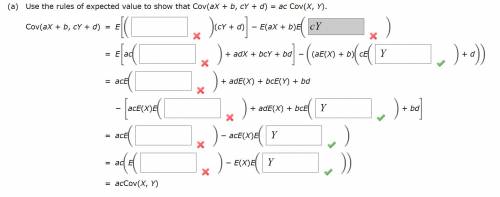(a)
Use the rules of expected value to show that
Cov(aX + b, cY + d) = ac Cov(X, Y).
...

Mathematics, 25.10.2021 09:10 yoyoyo42
(a)
Use the rules of expected value to show that
Cov(aX + b, cY + d) = ac Cov(X, Y).
(b)
Use part (a) along with the rules of variance and standard deviation to show that
Corr(aX + b, cY + d) = Corr(X, Y)
when a and c have the same sign.
(c)
What happens if a and c have opposite signs?




Answers: 1


Other questions on the subject: Mathematics

Mathematics, 21.06.2019 20:00, lucerogon7403
How can you construct perpendicular lines and prove theorems about perpendicular lines
Answers: 3

Mathematics, 21.06.2019 20:30, aaronw3743
Wrote and expression for the difference of p and 4
Answers: 1

Mathematics, 21.06.2019 23:30, sindy35111
Atown has a population of 17000 and grows at 2.5% every year. to the nearest year, how long will it be until the population will reach 19600?
Answers: 1

Mathematics, 22.06.2019 00:00, kittenface3428
28 x 12 + 34 = ? it's for a test that if i fail on i will not proceed into the honor roll society i always dreamed of!me! worth 50 !
Answers: 1
You know the right answer?
Questions in other subjects:


Chemistry, 03.07.2019 10:00



Mathematics, 03.07.2019 10:00




Mathematics, 03.07.2019 10:00

Spanish, 03.07.2019 10:00



